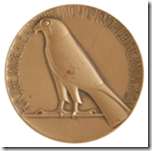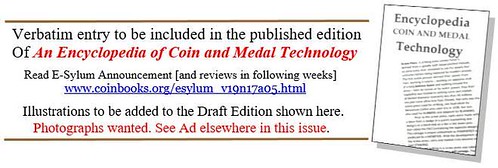
PREV ARTICLE
NEXT ARTICLE
FULL ISSUE
PREV FULL ISSUE
VOCABULARY TERM: CONGRUENT MASSDick Johnson submitted this entry from his Encyclopedia of Coin and Medal Terminology. Thanks. This opens a new weekly
feature; with over 1,800 terms it will take over 34 years to publish them all. -Editor
  Note the sunken area in the center of the reverse, formed by internal metal flowing into the high relief eagle on the obverse. Congruent mass is a problem for single struck coins where designers and engravers must eliminate this. It is not as critical for art medals which can be multiple struck. Congruent Mass. Heavy concentration of relief on one side of a coin or medal in respect to the corresponding point on the opposite side. An experienced coin or medal designer will never purposely put two areas of high relief back-to- back in a design to be struck. Such a situation creates very difficult problems for striking, as the core metal must flow from a greater distance to fill the two congruent die cavities. This creates an area of GHOSTING. For single struck pieces – as in coining – this is extremely difficult; for multiple- struck medals it can be accomplished but increases the number of blows and annealing required to fully STRIKE UP each piece. For cast medals congruent mass is not a problem. One way of separating masses on opposite sides of a coin or medal led to the widespread use of the WREATH as such a popular design element for the reverse. Obverses usually bear portraits with high relief in the center of the struck piece, the wreath on the reverse occupies an area surrounding this central area (and fits well within the circle); thus the two areas of mass are not back-to- back, not congruent. An early American example of inept design and congruent mass is the Hard Time token created for the Bergen Iron Works of Lakewood New Jersey (due, undoubtedly, to the die engraver's manifest inexperience). His high relief on both sides – an eagle on obverse and clasped hands on rev – prevent- ed any piece from being fully STRUCK UP as the devices on both sides always appear weakly struck. England's Royal Mint Report of 1932 (p 12) discussed this problem but called it "out of balance" designs. Reference: NC8 {1988} Breen, p 260 for problem U.S. Jefferson nickel.  Wayne Homren, Editor The Numismatic Bibliomania Society is a non-profit organization promoting numismatic literature. See our web site at coinbooks.org. To submit items for publication in The E-Sylum, write to the Editor at this address: whomren@gmail.com To subscribe go to: https://my.binhost.com/lists/listinfo/esylum All Rights Reserved. NBS Home Page Contact the NBS webmaster 
|